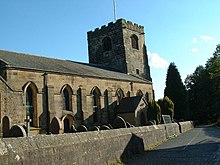St John the Baptist's Church, Broughton
| St John the Baptist's Church | |
|---|---|

St John the Baptist's Church from the northeast
|
|
| Coordinates: 53°48′13″N 2°43′00″W / 53.8035°N 2.7167°W | |
| OS grid reference | SD 5290 344 |
| Location | Church Lane, Broughton, Lancashire |
| Country | England |
| Denomination | Anglican |
| Website | St John the Baptist, Broughton |
| History | |
| Dedication | Saint John the Baptist |
| Architecture | |
| Status | Parish church |
| Functional status | Active |
| Heritage designation | Grade II* |
| Designated | 11 November 1966 |
| Architect(s) |
Robert Roper (nave) Austin and Paley (chancel) |
| Architectural type | Church |
| Style | Gothic, Gothic Revival |
| Completed | 1906 |
| Specifications | |
| Materials | Sandstone, slate roofs |
| Administration | |
| Parish | St John the Baptist, Broughton |
| Deanery | Preston |
| Archdeaconry | Lancaster |
| Diocese | Blackburn |
| Province | York |
| Clergy | |
| Vicar(s) | Shaun Baldwin |
| Laity | |
| Reader(s) | Joyce Wllacy Canon Andrea Titterington Jim Gibson |
| Director of music | John Catterall |
| Organist(s) | Nigel Spooner FRCO |
| Churchwarden(s) | Tracey Eves, Derek Millbank |
St John the Baptist's Church is in Church Lane, Broughton, Lancashire, England. It is an active Anglican parish church in the deanery of Preston, the archdeaconry of Lancaster, and the diocese of Blackburn. Its benefice is united with those of St Martin, Fulwood, and St Peter, Fulwood. The church is recorded in the National Heritage List for England as a designated Grade II* listed building.
The tower of the church is dated 1533. The rest of the church, which dated possibly as far back as the 14th century, was demolished in about 1823. The nave was rebuilt between 1823 and 1826. The architect for this work was Robert Roper. In 1905–06 the chancel, vestries, and an organ chamber were added by the Lancaster architects Austin and Paley. At the same time the whole building was restored, and the box pews were replaced by benches.
St John's is constructed in sandstone, and has slate roofs. Its plan consists of a five-bay nave, a north porch, a chancel with an organ chamber to the south, and a west tower. The tower is in three stages with diagonal buttresses, an embattled parapet and a southwest stair turret. On the west side of the tower is a doorway, above which is a three-light window with Perpendicular tracery. In the top stage are three-light louvred bell openings, and small gargoyles near the corners. A string course below the parapet carries the date 1533 on the south side. The nave is in Early English style, and has a large lancet window in each bay, the bays being separated by shallow buttresses. The chancel and organ chamber are in Perpendicular style, with square-headed windows, and an embattled parapet. The east window has three lights. In the gable of the organ chamber are re-set stones dating from the 16th century carved with the shields and initials of local families.
...
Wikipedia

